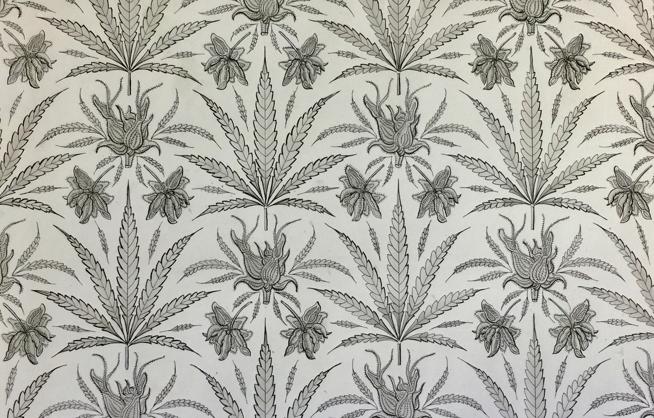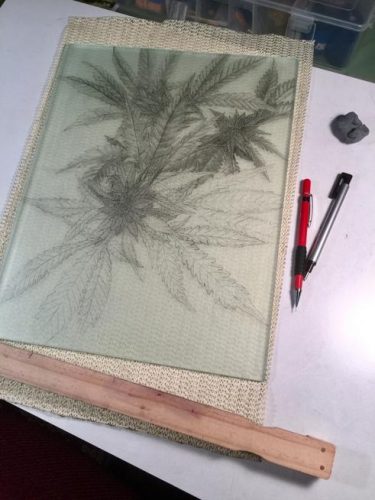By studying and sketching what nature is brewing, botanical artists have been helping scientists identify various plant species over centuries — for medicinal purposes, to study and maintain healthy ecosystems and to document rare and extinct species for publications.
And it doesn’t look so bad hanging on a wall, either.
This blend of art and science will come together in a rare exhibit at the University of Colorado’s Museum of Natural History with “Cannabis: A Visual Perspective,” opening in the BioLounge on Sept. 8.
With Colorado’s legalization of cannabis and the surging interest in its medicinal properties, the juried selection of 20 illustrations, presented by the Rocky Mountain Society of Botanical Artists, will hang in the form of watercolor, acrylic, oil, colored pencil, pastel, print and mixed media.
“This is the first exhibit of its kind that we know of in the United States,” said Suzanne Balog, the museum’s event and communications specialist. “We really want to focus on the artistic process as well as use this as a launching point to talk about the science that’s happening on campus on this flowering species of plant.”

Other than exploring the diversity of the plant, Balog said the exhibit will spotlight CU’s state-funded research grant that is being used to study the effects of high-potency cannabis.
“There’s a lot of teaching and learning that can happen from the starting point of a scientific illustration,” said Balog. “This is designed for the lens of science in mind, but it can still be absolutely beautiful.”
The art
Denver artist Susan T. Fisher, past president of the American Society of Botanical Artists and honorary director of the Rocky Mountain society, will display a piece in the exhibit. It was when she was initially sketching her solarplate etching of the sativa strain Charlotte’s Web, when she realized how complicated cannabis pants are.
“I spent two hours sketching a plant and, oh my, they are hugely complicated plants, let me tell you,” she said. “I thought, ‘What have I got myself into?'”
Fisher, former coordinator for Denver Botanic Garden’s botanical art program, has a stacked resume and an impressive display of work. To prepare for “Cannabis: A Visual Perspective,” she said the artists trekked to a grow facility in Longmont in January for initial sketching. Since cannabis became legal in Colorado in 2012, Fisher said the members of RMSBA have been interested in drawing the plant to establish visual records.
“It’s cool, we got to see fields and fields of plants,” Fisher said. “It was all very professional. They had booties for our feet, special lights on the plants and fans running. We sat there on our art stools, with sketchbooks in hand, studying these plants.”
Fisher said she gained a “huge respect for the cannabis industry.”
“These people are all very professional and genuinely interested in doing what they can to improve the industry,” Fisher said. “It’s not like what we used to think, smoke a doobie and get high, they’re experimenting and cross-pollinating different species for the future of cannabis as medicine.”
Which is equally important to the artists. (“Botanical art gets people to really look at the plant and appreciate the detail,” said Fisher.)
It’s the mix of science and art that has helped the art culminate in a resurgence, Fisher said.
“The world seems to be getting back to nature each day,” said Fisher. “Gardeners and horticulturists love their plants. I love my plants, I love weeding them, tending to them, watering them.”
And drawing them, like two famous Colorado botanical artists also did — Denver’s Ida Pemberton and Boulder’s Anne Ophelia Todd Dowden.
“People don’t always know about botanical artists, ” said Fisher, who also does artwork for the seed packets for the Broomfield company Botanical Interest. “These women should be well-known names in Colorado. They both did beautiful work.”
Pemberton’s collection of 64 botanical watercolors from the 1930-40s of plants she grew at her Denver home are being preserved by the Museum of Natural History, said Balog. When Pemberton died of stroke at the height of her career in 1955, her husband sold the watercolors to CU.
Dowden, whose bulk of work resides at The Hunt Institute at Carnegie-Mellon in Pittsburgh (where Fisher studied), grew up in Boulder, then moved back to Boulder in 1990 and lived there until she died in 2007 at age 99.
Even Pemberton sketched cannabis in the 1930s, “way back when marijuana might not have been a big bugaboo,” said Fisher.
The science
The attention to detail for botanical artists is crucial.
“Illustration for scientific purposes is a very exact and precise art form,” said Fisher. “It has to be just right all the way down to the leaf veins. If it’s for scientific observation, the requirements are very tough. The art has to be precise and recognizable.”
Think about when Charles Darwin would explore, said the Museum of Natural History’s Balog.
“There was always a naturalist and there was always an illustrator,” Balog said. “Sure, they could collect specimens but they didn’t have ways to capture them in their natural state.”

With modern, high-tech cameras, why not capture a plant in a click? Balog said cameras usually zero in on one focal point and tend to blur the rest.
And there’s more, Fisher said.
“Cameras are better than they’ve ever been before,” said Fisher. “However, scientific drawings can compare scale, can show you the inside of the seed, that can be placed next to the plant and be compared to the plant ovary. You can show the complicated root systems, the blossoms. Then you can combine them all in sizes that make sense to a botanist so they can compare them to scale.”
Plus, botanical art breaks up the world’s daily over-saturation of images, said Fisher.
“We’re swamped with images in this day and age, we’re so inundated,” she said. “These personalized images make for a different perspective, they give greater connections to the plant itself.”
Fisher said lately it seems like people are connecting to nature in a way that they never have before.
“It’s funny, the minute it starts to disappear, we want more of it,” Fisher said. “Which makes this an art form that will always be relevant.”
If you go
What: Cannabis: A Visual Perspective
When: Exhibit starts Sept. 8 and runs through Jan. 31, 2018
Where: CU Museum of Natural History, Henderson Building, 15th and Broadway, Boulder
Cost: Free, donations accepted
More info: colorado.edu/cumuseum
